 |
 |
| 元屋敷窯 Motoyashiki kiln [Photos taken on July27, 2003] |
| 2003年7月27日岐阜県土岐市泉町久尻にある「織部の里公園」内にある 「元屋敷陶器窯跡」、公園に隣接している「清安寺」及び「土岐市美濃陶磁歴史館」 へ行ってきました。 「元屋敷陶器窯跡」には復元された連房式登窯(14房の焼成室)が1つ、大窯が 3つ(内2つは復元されている)あり、整備が行き届いています。 「清安寺」は曹洞宗の寺院で美濃陶業にたずさわった人々の菩提寺です。 「土岐市美濃陶磁歴史館」では「縄文と渦巻文様の世界−縄文土器の魅力」と と題して企画展が催されていました。 この時代はロクロや窯を用いず、粘土を 野焼きで焼成する縄文土器が製作されました(パンフレット一部引用)。 東北地方から出土した壷は、形がよく、大きく、縄文が美しく、草木の灰が土器に あたかも釉薬のごとく掛かっており、味わいがありました。 また、「元屋敷陶器窯跡」のパンフレットによれば、桃山時代(16世紀後半)、 美濃地域は日本最大の施釉陶器生産地でした。[注1参照] [注1] 美濃地域が日本最大の施釉陶器生産地だった原因は下記下線部とHP作成者推定。 (「2002年10月5日の名古屋工業大学名誉教授 国分氏講義メモ」より引用) 1498年東海地方にマグニチュード8.2〜8.4の大地震発生と、戦乱に明け暮れて いる間に瀬戸の陶工たちが以前の半世紀にわたる保内商人の交易ルートである 多治見市、土岐市、可児市など、土岐川の北部地区に向かって移動を始めた。 たとえ信長が伊勢・北畠氏を滅亡し保内(八日市市)商人による鈴鹿山脈の千草越え のルートはほぼ消滅しても、従来の流通ライン(瀬戸、庄内川、熱田宮、津島、桑名、 伊勢越え)が復活しなかった。 それでも、打ちひしがれていた瀬戸の陶器は 約100年の雌伏の後、復活の新たな兆しを示し始めた。 I have been to "Motoyashiki Ceramic Kiln Ruins" (nationally designated historical site) in "Oribe's village park" located in Izumi-cho Kujiri, Toki City, Gifu Prefecture on July 27, 2003. Further, I visited "Seianji Temple" and "Toki City Mino-Ware History Hall" which are adjoine to the Kiln Ruins. One14-chambered climbing kiln and three Ohgama kilns (two of them are restored) are cleanly layouted and maintained at the Kiln Ruins. "Seianji Temple" is a temple of Soto sect of Budhiism and a family temple of people engaged in business of Mino-Ware pottery. At "Toki City Mino-Ware History Hall", a plan exhibition is being held on a title of "World of Jyomon and Swirl Pattern - Charm of Jyomon Earthenware". At this time, Jyomon Earthenware were produced by firing china clay body in a field without potter's wheel or kiln (Cited partially from a pamphlet). The jars excavated from the Tohoku district is of good form, large, of beautiful Jyomon pattern, ashes of plants are applied to the earthenware like glaze, and they are palatable. According to the pamplet, Mino was the biggest production area of pottery with glaze in Japan in Momoyama era (the latter half of 16th century). [See Note 1] [Note 1] HP writer presumes that the reason why Mino was the biggest production area of glazed pottery in the latter half of 16th century is: (Cited partially from texts of a lecture by Mr. Kokubu, emeritus professor of Nagoya Institute of Technology on Oct. 5, 2002) The big earthquake of magnitudes 8.2-8.4 occurred in the Tokai district in 1498. In addition, during this period, society was devoted to war. So, the potters of Seto began movement toward the trade route of the Honai merchant over a former half-century. The route had been made along the north part of the Toki River. That is to say, the route consisted of Tajimi, Toki , Kani and the others in East Mino district (Gifu Prefecture at present). Even if a general Oda Nobunaga defeated influential warriors, Mr. Ise and Mr. Kitabatake to extinguish a distributin route by merchants from Honai (Youkaichi City at present) which pass the Chigusa Pass.of the Suzuka mountains, a distribution route as in the past did not come to life again. The past route had consisted of Seto, the Shonai river, Atsuta, Tsushima, Kuwana and Ise. Nevertheless, pottery of beaten Seto began to show a new sign of revival after having been lying low for about 100 years. |
| 元屋敷陶器窯跡への入口 Enterance to Motoyashiki Ceramic Kiln Ruins |
清安寺 Seianji Temple |
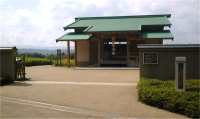 |
 |
| 連房式登窯 Multi-chambered climbing kiln |
|
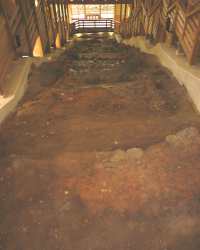 |
| 出土品 黒織部茶碗 Artifact Kuro-oribe bowl |
出土品 織部黒茶碗 Artifact Oribe-guro bowl |
出土品 黒織部茶碗 Artifact Kuro-oribe bowl |
出土品 灰釉折縁皿 Artifact Ash-glazed plate with flange |
 |
 |
 |
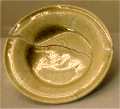 |
| 大窯(1号窯) の焚口 Firing port of Ohgama kiln (No.1) |
大窯(1号窯) の後部 Rear of Ohgama kiln (No.1) |
大窯(2号窯) 窯の内部構造が わかるように復元 Ohgama kiln (No.2) restored so as to be seen the inside |
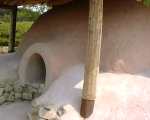 |
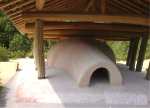 |
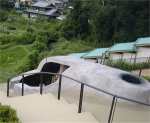 |